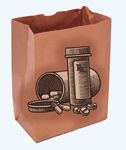Final rules may slow brown bagging
Final rules on hospital participation in Medicare and Medicaid may help pharmacists crack down on patients who try to provide their own drugs for hospital use. The practice is called "brown bagging," from the brown paper bags patients get from retail pharmacies.

"Payers are pushing patients to buy their own drugs at retail or specialty pharmacies and bring them in for administration," said Ernest Anderson of the Lahey Clinic pharmacy in Burlington, Mass. "Plans save money by buying at retail prices and sticking patients with their usual outpatient co-pay. We don't like it because we don't know where the drug was stored, how it was handled, or even for sure what it is, but we still have to administer it. It's a real liability issue."
Brown bagging is also a financial issue for hospitals. Third-party reimbursement rates assume the hospital that administers a drug is also buying, storing, and preparing the product. Reimbursement for drug preparation and other expenses is built into product reimbursement rates.
The Centers for Medicare & Medicaid Services may have inadvertently provided a solution. Final rules on hospital conditions for participation in Medicare and Medicaid that were published in the Federal Register last Nov. 27 require the safe storage and handling of medications. Other provisions cover requirements for patient histories and physical exams, verification of verbal orders, and patient evaluations following the use of anesthesia. The proposed rules were published in March 2005.
In general, the new rules codify procedures that are already being followed by most hospitals, said Nancy Foster, VP for quality and patient safety policy at the American Hospital Association. Each patient must have a history and physical exam no more than 30 days before or 24 hours following admission. History and exam may be conducted by a physician or other practitioner in accordance with state law and hospital policy.
All orders, including verbal orders, must now be documented and authenticated in the patient's medical record. Orders must be legible, dated, timed, and authenticated in written or electronic form by the person who ordered the service or by another practitioner who is responsible for the care of that patient.
Inpatients who are given anesthesia must be evaluated within 48 hours after surgery by a person who is qualified to administer anesthesia.
Finally, the new rules require that all drugs and biologicals be kept in secure areas and locked when appropriate pharmacy or other hospital personnel are not on duty. In addition, all scheduled drugs (II, III, IV, and V) must be kept in a locked area within secure confines.
The issue of brown bagging was not addressed in either the proposed rules or the final rules. In discussing the final rule, CMS noted that hospitals have the flexibility to integrate patient self-administration of drugs and biologicals as appropriate.
Self-administration typically includes urgent medications such as nitroglycerine tablets and inhalers kept at the bedside. CMS also noted that the rule supports the common practice of keeping nonprescription products at the bedside for patient use. All other drugs used in the hospital setting must be kept in a secure environment.
"A lot of what is in this rule mirrors existing standards from the Joint Commission on Accreditation of Healthcare Organizations," Anderson said. JCAHO standards on the proper preparation, handling, and storage of drugs give hospitals limited leverage to prevent brown bagging, he said. JCAHO can advise, but not require, specific practices. He said the new CMS rule will be more helpful because it specifically requires hospitals to store all drugs used in the facility in a safe and secure fashion.
"You can't tell me that a patient handing me a paper bag of meds that may have been baking in the car for days constitutes proper, safe, or secure storage," Anderson said.